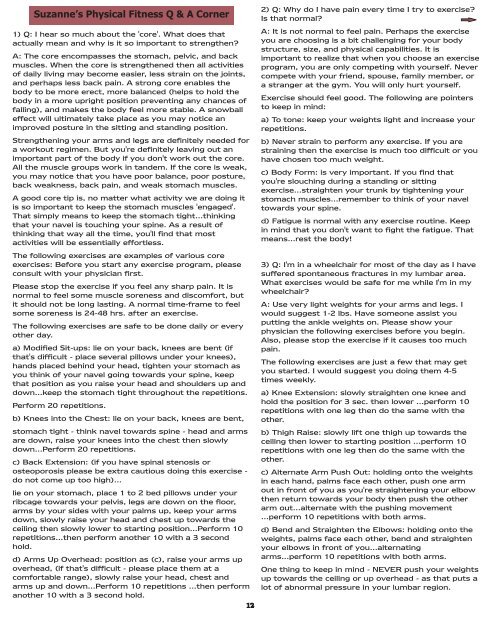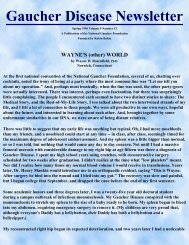Gaucher Community News - National Gaucher Foundation
Gaucher Community News - National Gaucher Foundation
Gaucher Community News - National Gaucher Foundation
Create successful ePaper yourself
Turn your PDF publications into a flip-book with our unique Google optimized e-Paper software.
Suzanne’s Physical Fitness Q&ACorner<br />
1) Q: I hear so much about the 'core'. What does that<br />
actually mean and why is it so important to strengthen?<br />
A: The core encompasses the stomach, pelvic, and back<br />
muscles. When the core is strengthened then all activities<br />
of daily living may become easier, less strain on the joints,<br />
and perhaps less back pain. A strong core enables the<br />
body to be more erect, more balanced (helps to hold the<br />
body in a more upright position preventing any chances of<br />
falling), and makes the body feel more stable. A snowball<br />
effect will ultimately take place as you may notice an<br />
improved posture in the sitting and standing position.<br />
Strengthening your arms and legs are definitely needed for<br />
a workout regimen. But you're definitely leaving out an<br />
important part of the body if you don't work out the core.<br />
All the muscle groups work in tandem. If the core is weak,<br />
you may notice that you have poor balance, poor posture,<br />
back weakness, back pain, and weak stomach muscles.<br />
A good core tip is, no matter what activity we are doing it<br />
is so important to keep the stomach muscles 'engaged'.<br />
That simply means to keep the stomach tight...thinking<br />
that your navel is touching your spine. As a result of<br />
thinking that way all the time, you'll find that most<br />
activities will be essentially effortless.<br />
The following exercises are examples of various core<br />
exercises: Before you start any exercise program, please<br />
consult with your physician first.<br />
Please stop the exercise if you feel any sharp pain. It is<br />
normal to feel some muscle soreness and discomfort, but<br />
it should not be long lasting. A normal time-frame to feel<br />
some soreness is 24-48 hrs. after an exercise.<br />
The following exercises are safe to be done daily or every<br />
other day.<br />
a) Modified Sit-ups: lie on your back, knees are bent (if<br />
that's difficult - place several pillows under your knees),<br />
hands placed behind your head, tighten your stomach as<br />
you think of your navel going towards your spine, keep<br />
that position as you raise your head and shoulders up and<br />
down...keep the stomach tight throughout the repetitions.<br />
Perform 20 repetitions.<br />
b) Knees into the Chest: lie on your back, knees are bent,<br />
stomach tight - think navel towards spine - head and arms<br />
are down, raise your knees into the chest then slowly<br />
down...Perform 20 repetitions.<br />
c) Back Extension: (if you have spinal stenosis or<br />
osteoporosis please be extra cautious doing this exercise -<br />
do not come up too high)...<br />
lie on your stomach, place 1 to 2 bed pillows under your<br />
ribcage towards your pelvis, legs are down on the floor,<br />
arms by your sides with your palms up, keep your arms<br />
down, slowly raise your head and chest up towards the<br />
ceiling then slowly lower to starting position...Perform 10<br />
repetitions...then perform another 10 with a 3 second<br />
hold.<br />
d) Arms Up Overhead: position as (c), raise your arms up<br />
overhead, (if that's difficult - please place them at a<br />
comfortable range), slowly raise your head, chest and<br />
arms up and down...Perform 10 repetitions ...then perform<br />
another 10 with a 3 second hold.<br />
2) Q: Why do I have pain every time I try to exercise?<br />
Is that normal?<br />
A: It is not normal to feel pain. Perhaps the exercise<br />
you are choosing is a bit challenging for your body<br />
structure, size, and physical capabilities. It is<br />
important to realize that when you choose an exercise<br />
program, you are only competing with yourself. Never<br />
compete with your friend, spouse, family member, or<br />
a stranger at the gym. You will only hurt yourself.<br />
Exercise should feel good. The following are pointers<br />
to keep in mind:<br />
a) To tone: keep your weights light and increase your<br />
repetitions.<br />
b) Never strain to perform any exercise. If you are<br />
straining then the exercise is much too difficult or you<br />
have chosen too much weight.<br />
c) Body Form: is very important. If you find that<br />
you're slouching during a standing or sitting<br />
exercise...straighten your trunk by tightening your<br />
stomach muscles...remember to think of your navel<br />
towards your spine.<br />
d) Fatigue is normal with any exercise routine. Keep<br />
in mind that you don't want to fight the fatigue. That<br />
means...rest the body!<br />
3) Q: I'm in a wheelchair for most of the day as I have<br />
suffered spontaneous fractures in my lumbar area.<br />
What exercises would be safe for me while I'm in my<br />
wheelchair?<br />
A: Use very light weights for your arms and legs. I<br />
would suggest 1-2 lbs. Have someone assist you<br />
putting the ankle weights on. Please show your<br />
physician the following exercises before you begin.<br />
Also, please stop the exercise if it causes too much<br />
pain.<br />
The following exercises are just a few that may get<br />
you started. I would suggest you doing them 4-5<br />
times weekly.<br />
a) Knee Extension: slowly straighten one knee and<br />
hold the position for 3 sec. then lower ...perform 10<br />
repetitions with one leg then do the same with the<br />
other.<br />
b) Thigh Raise: slowly lift one thigh up towards the<br />
ceiling then lower to starting position ...perform 10<br />
repetitions with one leg then do the same with the<br />
other.<br />
c) Alternate Arm Push Out: holding onto the weights<br />
in each hand, palms face each other, push one arm<br />
out in front of you as you're straightening your elbow<br />
then return towards your body then push the other<br />
arm out...alternate with the pushing movement<br />
...perform 10 repetitions with both arms.<br />
d) Bend and Straighten the Elbows: holding onto the<br />
weights, palms face each other, bend and straighten<br />
your elbows in front of you...alternating<br />
arms...perform 10 repetitions with both arms.<br />
One thing to keep in mind - NEVER push your weights<br />
up towards the ceiling or up overhead - as that puts a<br />
lot of abnormal pressure in your lumbar region.













